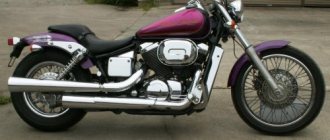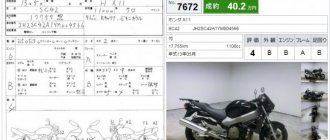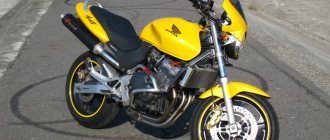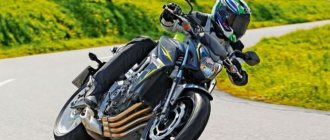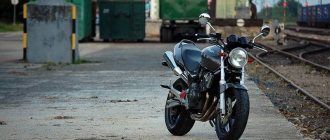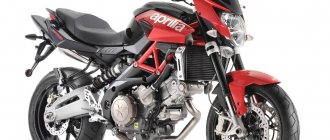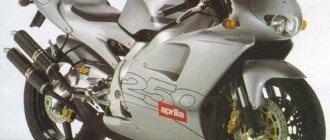What kind of motorcycle is this anyway?
The first Honda Hornet motorcycles began to be sold back in 1998
, and today there are still good examples among them that are not a shame to buy.
But, it is advisable to take something fresher. The engine is a slightly reworked and throttled engine from the CBR600RR
. It has proven itself to be the best, truly reliable and powerful.
Frame of the Hornet
, which is how
“Hornet”
, is relatively simple, made of aluminum alloy, therefore lightweight and durable. Externally, the motorcycle looks modern and aggressive, even if we talk about its first modifications.
A good frame, engine, suspension and design - it is because of this that the motorcycle has become really popular, and today it can be seen at any motorcycle rally.
To date, production of the motorcycle has not been suspended; it continues to be produced, but somewhat updated. Periodically, the bike was modernized, but the changes were minor.
In 2000, it was decided to remove the 16-inch front wheel and replace it with a seventeen-inch one.
.
After that, the engineers touched the tank of this motorcycle - it was increased to 17 liters
.
In 2007, the manufacturer decided to update the power unit by modernizing it, which immediately affected the technical characteristics. The power system was replaced, the ignition system was improved, and the design was also not left without attention. So far, the last processing was carried out in 2009
, and the appearance of the bike remains unchanged to this day.
One gets the impression that the manufacturer did not want to change anything in the appearance of this motorcycle, but was determined to make it modern and as comfortable as possible.
I heard several times that improvements were made to the suspension, steering and riding position.
Total
The main advantage of the Honda CB600 Hornet is its versatility and balance . Full-size and comfortable, but not too heavy, it can give even an experienced and experienced motorcyclist a huge dose of adrenaline. At the same time, reviews from SB600 owners are mostly strictly positive. This bike can be called one of the best models ever to roll off Honda's production lines, and we can confidently say that the CB 600F will be actively sold and bought on the secondary market for many, many years to come.
Specifications
| Maximum engine power: | 94 - 102 at 12000 rpm HP |
| Torque: | 62.76 at 9500 rpm - 63.50 at 10500 rpm Nm |
| Working volume: | 599 cm3 |
| Motor type (cylinder arrangement, number of strokes): | 4-cylinder, 4-stroke, in-line |
| Number of cylinders: | 4 |
| Number of valves: | |
| Intake type (Injector / Carburetor): | |
| Bore and stroke: | |
| Starting system (Electric starter, kick starter): | |
| Maximum speed in km/h: | 225 km/h |
| Cooling system: | Liquid cooling |
| Transmission (gearbox): | 6-speed |
| Clutch (Dry / Wet): | |
| Drive unit: | Chain |
| Frame: | Steel (aluminum 2007-2012) |
| Chassis | |
| Suspension (front/rear travel): | |
| Brakes (Front/Rear): | |
| Wheels / Tires / Rubber: | |
| Dimensions and weight | |
| Dimensions (Length / Width): | |
| Seat height: | |
| Ground clearance: | |
| Curb weight: | |
| Wheelbase: | 1420 mm |
| Weight: | 196 -198 kg |
| Fuel tank capacity: | 16 - 19 l. |
| Battery capacity: | |
| Year of release: | |
| Country of Origin: |
Appearance
The founder of the naked class is the Suzuki Bandit bike.
In contrast, another Japanese company, Honda, created its own naked bike, the factory designation of which was CB 600 F, and the full name of this bike is Honda Hornet CB 600 F.
The appearance of the Honda Hornet CB 600 F is truly impressive.
The bike doesn’t have many color options; a two-tone color scheme is often used – most often the main color of the motorcycle is black or blue .
But some elements of the motorcycle create contrast with their golden color .
The rims and front fork of this motorcycle have a gold finish.
The plastic elements on this bike include a small front fairing with an arrow-shaped headlight installed in it, the side covers of the glove compartments under the seat and the rear fender trim.
The engine is open , with a massive cooling radiator installed in front of it.
There are four exhaust pipes coming out of the cylinders, but under the motorcycle they are combined into one common pipe.
The exhaust pipe on this bike is protected by chrome trim and runs along the right side of the motorcycle.
The tank of the Honda SB 600 Hornet is high , with a small amount of space on the seat. The seat itself is double, stepped.
Model history
1998 - start of production and sales of the Honda Hornet 600. The first generation of the motorcycle. The model has a steel backbone frame and a 16′ front wheel.
2000 - The Honda Hornet 600 model is slightly updated, receiving a 17′ front wheel, a slightly longer wheelbase and a redesigned front fork. In parallel with the usual modification, the S version (with fairing) is produced.
2003 - second generation of the motorcycle. The Honda Hornet 600 gets a major update, with a slightly more modern design for both the bike and the dashboard. The fuel tank capacity increases by 1 liter (up to 17 liters), an inverted fork is installed instead of the usual one, the brake system is slightly updated (instead of the 2nd generation Nissin, the 3rd generation Nissin is installed), and a HISS immobilizer appears. The S modification is no longer offered for purchase.
Comparison of the Honda CB 600 F Hornet motorcycle with the Honda CBR600F4i
2007 - third generation of the motorcycle. The Honda Hornet 600 is being seriously updated both externally and technically. The appearance becomes similar to modern naked cars, the engine is now installed from the sports Honda CBR600RR (producing 102 hp), an injector is used instead of carburetors, the brake system is updated (a combined anti-lock braking system - C-ABS is optionally available), the fuel tank increases to 19 liters .
2012 is the last year of production of the Honda CB 600 Hornet model (official sales continued until 2013).
2014 - The Honda CB650F motorcycle was introduced as the official successor to the Honda CB 600 Hornet.
Similar models
- Yamaha FZ6-N . The famous “Phaser” from , stylish, tenacious and dynamic.
- Kawasaki ER-6F . In terms of technical characteristics, the bike from the evergreen manufacturer is inferior to the Honda CB600F Hornet, but it is cheaper. Plus, the ER-6F is great for beginners due to its friendly nature.
- Suzuki GSR 600. Competing with the second and third generations of the SB600 Hornet, this motorcycle has earned a good reputation due to its high reliability and interesting design.
Specifications:
| Road (street, naked) | |||
| steel | aluminum | ||
| 4-cylinder, 4-stroke, in-line | |||
| 599 cc cm. | |||
| 65 mm x 45.2 mm | 67mm x 42.5mm | ||
| 12,0:1 | |||
| liquid | |||
| DOHC, 4 valves per cylinder | |||
| carburetor, 4x 34 mm Keihin CV (flat throttle) | electronic injection PGM-FI | ||
| fully transistorized | |||
| 94.69 hp at 12000 rpm | 94.00 hp at 12000 rpm | 96.50 hp at 12000 rpm | 102 hp at 12000 rpm |
| 62.76 Nm at 9500 rpm | 61.78 Nm at 10000 rpm | 63.00 Nm at 10000 rpm | 63.50 Nm at 10500 rpm |
| 6-speed | |||
| chain | |||
| 130/70ZR16 61W | 120/70ZR17 58W | ||
| 180/55ZR17 73W | |||
| 2 discs 296 mm, 2-piston calipers | 2 discs 296 mm, 2-piston calipers (optional C-ABS - 3-piston) | ||
| 1 disc 220 mm, 1-piston caliper | 1 disc 240 mm, 1-piston caliper (optional ABS) | ||
| 41 mm telescopic fork, travel - 112 mm | 41 mm telescopic inverted fork (since 2005), travel - 109 mm | ||
| pendulum with monoshock absorber (preload adjustment), stroke - 127 mm | |||
| 2080 x 740 x 1055 mm (2100 x 740 x 1070 mm - 2005-2006) | 2085 x 760 x 1090 mm | ||
| 795 mm (790 mm - 2005-2006) | 800 mm | ||
| 1420 mm | 1435 mm | ||
| 3.3 sec | |||
| 225 km/h | |||
| 16 l (including reserve - 3 l) | 17 l (including reserve - 2.6 l) | 19 l | |
| 196 kg (200 kg - 2005-2006) | 198 kg (205 kg - versions with ABS) | ||
Technical characteristics of Honda CB 600
Depending on the year of manufacture, Hornets can be quite different, but their main characteristics have remained almost unchanged. Thus, the power of a 4-cylinder liquid-cooled engine ranges from 94 to 102 hp. , and torque - from 62 to 63.5 Nm . The first two generations of the bike are very similar to each other, but in 2007 a major restyling was carried out. Four carburetors were replaced with an injector , the steel frame was replaced by a light alloy one (which, oddly enough, had no effect on the overall weight of the motorcycle), and the conventional fork was changed to an “upside-down” one. The volume of the gas tank has increased over the years from 16 to 19 liters , but fuel consumption, on the contrary, has decreased from about 6-6.5 liters to 5.5 liters AI-92 at a cruising speed of 120 km/h . The classic 6-speed gearbox has not undergone any noticeable changes over the years. And really, why improve something that is already beautiful?
The dimensions of the Honda SB 600 Hornet immediately attract attention. It can easily be confused with its liter “big brother” if you don’t know the minor differences between the models. This is both a plus and a minus - even the tallest biker will most likely be very comfortable on this motorcycle, and even the second number will not have to be crowded. However, it is not so easy to move it on the spot, and short motorcyclists will have a hard time due to the significant height of the saddle (795-800 mm). But thoughts about all these shortcomings instantly disappear as soon as you drive the Honda CB600F Hornet onto the road and turn the throttle towards you.
This is where all the advantages of the motorcycle are fully revealed. Insane acceleration (only 3.3 seconds to 100 km/h - no worse than many liter sportbikes!) up to 150-160 km/h, excellent brakes with two 296 mm discs at the front and a 220 mm disc (240 mm on the 3rd generation) at the rear, a maximum speed of 225 km/h , a spacious tank - what else is needed for happiness? The suspensions, of course, are simple, but the Hornet 600 obeys the steering wheel perfectly, and driving it is a pleasure .
Honda CB 600 F Hornet
Second generation (2003-2006)
The manufacturer started thinking about the first modification of the Honda CB 600 Hornet after 2000. Then the main emphasis was on lengthening the base and redesigning the front fork to accommodate 17-inch wheels. A little later, the Honda cb 600 line was supplemented with an S version with a front fairing. True, in 2003 its production was discontinued due to the release of the second generation of the theme hero. The new Hornet differed from its predecessor in its fresh design, improved instrument panel, upside-down fork, immobilizer, universal brake pads from Nissin, as well as a larger 17-liter gas tank.
In parallel with the Honda cb 600, the range of the Japanese manufacturer was supplemented by the Honda SBF 600, which was intended to push aside the model with the “500th” engine. In particular, we are talking about the Honda cbf 500.
